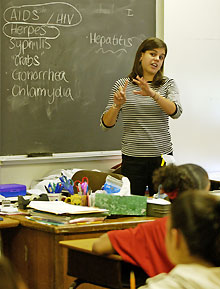For more archives, go to the Advance Archive/Search Page.
Medical Students Bring Health Education
To Hartford's Public Schools
One girl wondered if nail polish can harm a developing baby. Another wanted to know if you can get AIDS from sharing a glass.
 |
Margo Robinson, a third-year dental student, teaches health issues to sixth graders at Martin Luther King School in Hartford.
|
These youngsters had their questions answered by medical and dental students from the Health Center as part of a community outreach program that brings health education to sixth graders in Hartford.
By the end of the 2003-04 academic year, the program had for the first time reached every sixth-grade classroom in the Hartford public schools: that's nearly 2,000 kids in 57 classrooms.
"Teaching health classes in Hartford is a community service project for us," says Margo Vallee, a second-year medical student who taught the classes in 2002-2003 and handled recruiting and scheduling this year. "For the past several years, we have been expanding the program to reach more sixth graders. This year, our goal was to reach everyone and we did it. It took 114 first- or second-year students, but we reached every sixth-grade classroom."
The medical and dental students traveled in teams of two to Hartford's public schools to teach the sixth-grade classes for an hour a week for five weeks during the school year. They spoke to the youngsters about health and human development, including puberty, anatomy, and reproduction; violence prevention; decision-makin g; and nutrition.
"Kids today seem to know a lot more than their parents did at the same age. But not all their information is accurate," says Vallee. "Our goal was to teach them basic health information and answer their questions as accurately as we could."
A question box helped ensure that every student who had a questions could ask it.
"Some of the kids are comfortable talking in class. Others are shy," says Natalie Zimmerman, a second-year medical student who taught the classes in 2003-04. "By putting their question in the box outside of class, kids can ask a question anonymously, without worrying about what their classmates will think."
The community service program offered by the medical and dental students supplements the work of the school system's health education department. "We have five health educators for 13,000 elementary students in grades kindergarten through eight," says Vic Neumann, team leader for health education for Hartford's school system. "The Health Center students are a great resource for our health educators and the classroom teachers."
The curriculum, originally developed with the help of the Health Center's Department of Community-Based Education and the Hartford Board of Education, is periodically revised and adjusted to meet the needs of the students and the teachers.
The program began in 1995 after medical student Trish Kritec took an elective course in urban health and focused on school health in Hartford. That was the year elementary school health education teachers were eliminated from the Hartford school budget. Kritec and two other students volunteered to help develop a curriculum and teach it to six classes of sixth graders.
Even after funding was restored, medical and dental students continued to provide welcome support. The program proved so popular that the school system asked the Health Center students to expand it to the entire sixth grade.
"We wanted to focus on the sixth grade because these students are really young adults," says Neumann. "They are on the threshold of making decisions that will impact the rest of their lives."
The program is now a formal community service program for the medical school. With the help of small grants, the students have purchased anatomical models, charts, videos, and other educational materials. There is a formal orientation process for Health Center students who want to participate. Says Vallee, "It's become very popular."

